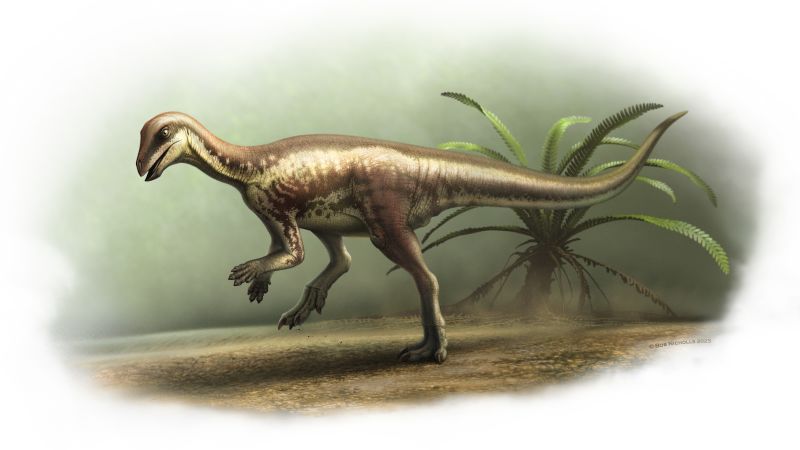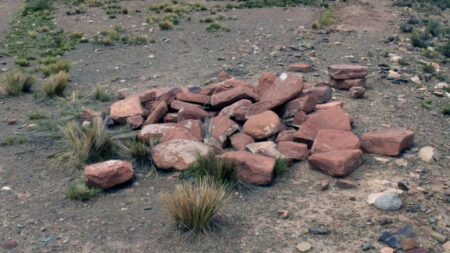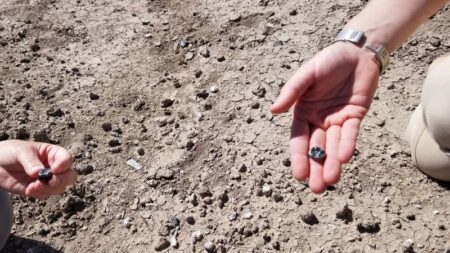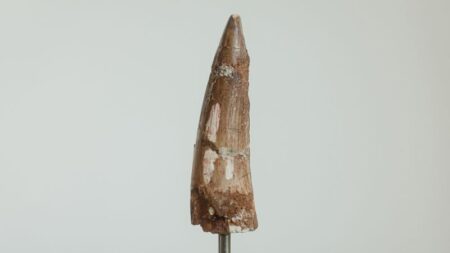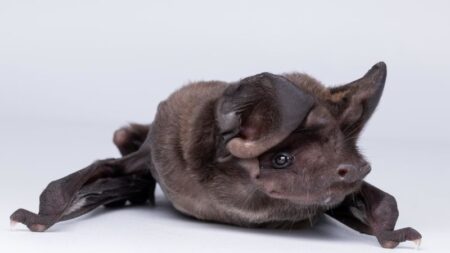**New Discovery in the Dinosaur Kingdom: The Enigmacursor mollyborthwickae**
In a significant discovery for paleontology, scientists have identified a new species of dinosaur-known as Enigmacursor mollyborthwickae- that lived approximately 150 million years ago in what is now the United States. This remarkable dinosaur was about the size of a Labrador retriever, illustrating that not all dinosaurs were colossal creatures like the iconic stegosaurus or diplodocus that often dominate textbooks and films. This finding has broadened our understanding of these ancient ecosystems.
The details of this new species were unveiled through a study published in the Royal Society Open Science. Researchers led by Professor Paul Barrett from London’s Natural History Museum were instrumental in this remarkable find. The Enigmacursor mollyborthwickae boasted a tail that constituted nearly half of its body length, which posed intriguing questions regarding its behavior and ecological role. Despite significant bone discoveries made in the Morrison Formation in Colorado between 2021 and 2022, the absence of the skull and parts of the vertebral column has left scientists speculating about the exact dimensions of this dinosaur.
Professor Barrett highlighted the rarity of discovering small plant-eating dinosaurs. He shared insights with CNN, mentioning that it’s uncommon to find a well-preserved skeleton, as most fossils end up being just fragments. This hindrance poses substantial challenges in fully understanding the characteristics and lifestyle of these lesser-known dinosaur species.
The skeletal remains of the Enigmacursor are set to be displayed in London’s Natural History Museum from June 26. Barrett pointed out that this dinosaur was relatively slender, weighing in similar to a collie, suggesting that it was a herbivore. Its anatomy indicates that the Enigmacursor walked on its long hind legs, which implies it was a speedy runner that could efficiently escape from predators. This aspect of its life hints at a dynamic interaction with other dinosaurs in the same habitat.
The journey of uncovering this species started when a London art gallery brought the dinosaur skeleton to the attention of Barrett and his colleague, Susannah Maidment. Collaborating with the gallery allowed them to secure a donor to facilitate the skeleton’s transfer to the museum. The species embodies a dedication to education and science, as its name commemorates the donor, Molly Borthwick. The genus name, which translates to “mysterious runner” from Latin, evokes curiosity and excitement about the creature’s lifestyle.
Through extensive examination of the bones, Barrett and Maidment established that this specimen possessed unique features distinct from previously recognized species. Notably, the thigh bone exhibited different muscle attachment sites, prompting discussions about the evolutionary trajectory of smaller herbivorous dinosaurs. Interestingly, the Enigmacursor is closely related to Yandusaurus hongheenis, a dinosaur found in China, raising hypotheses about the migration and distribution of dinosaur species across continents.
Although it is surmised that the Enigmacursor designated in this unique specimen had not yet reached full maturity, some vertebrae had not fused. However, uncertainties remain regarding its premature death, as no evident signs of illness or injury were found in the remains. The challenge of identifying the cause of death underscores the complexities faced by paleontologists when interpreting fossil evidence.
While new dinosaur species are frequently discovered—about one every week, according to Barrett—the emergence of smaller species like the Enigmacursor is rarer. These diminutive dinosaurs often escape the attention of fossil hunters focused on more impressive, larger fossils and could also more easily fall prey to other creatures, leading to their bones being scattered. Such finds contribute to a more comprehensive understanding of the diverse ancient ecosystems that existed during the Dinosaur Age.
In summary, the identification of Enigmacursor mollyborthwickae expands our perspective on the diversity of dinosaurs and their ecological relationships in prehistoric environments. The lightweight, speed-oriented design of this dinosaur gives us a glimpse into its behavioral responses toward living alongside larger dinosaurs, enriching the narrative of life millions of years ago. This discovery reinforces the importance of continuous exploration in paleontology to unveil the intricate tapestry of life on Earth during one of its most fascinating periods.






